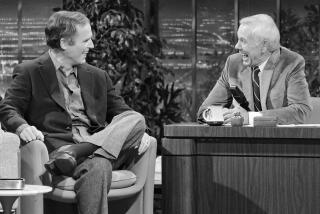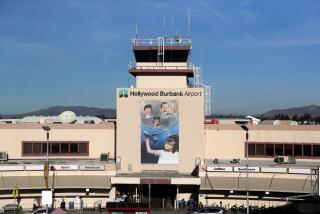Hospital Uses Renovations, Advertising in Fight for Life : Health care: Burbank Community Hospital faces a decline in patients and a projected $1-million loss.
- Share via
Burbank Community Hospital, whose image was tarnished when a county investigation turned up serious health-care deficiencies in 1987, could be closed or sold if major renovations and a public relations campaign do not stem a steady decline of patients over the past four years, hospital officials said.
Hospital Administrator William Daniel said the $300,000 in improvements, which include painting the entire hospital as well as installing new carpeting and furniture, are crucial to attract more patients. Hospital records show that the average daily number of patients visiting the 103-bed facility has dropped from 48 in 1984 to 33 in 1989.
“We have a break-even point at 35 or 36 patients,” Daniel said. “But over time, that’s not good enough for this hospital to really make it.
“If we can’t re-establish an economic relationship with the community, then we have to look at the predictable set of options,” which could include closing the facility or selling it, he said.
“Our goal here is to make this as physically accommodating and comfortable as any hospital,” Daniel said.
Burbank Community Hospital, which is run by a nonprofit foundation and has an annual operating budget of $12 million, lost $1.3 million in 1988 and is expected to lose about $1 million this year, Daniel said. The hospital has been forced to dip into its cash reserves, about $2.5 million, to keep itself going and to pay for the renovation.
Larry Shoaf, vice president of the hospital’s board of trustees, said the hospital had no choice but to upgrade. “Our decision was to make improvements to allow us to be more profitable in the future, to be the quality institution we need to be,” he said.
Daniel said several factors are responsible for the decline in patients: poor planning by the hospital, a recent increase in outpatient services throughout the health-care industry, the proximity of the massive and better equipped St. Joseph Medical Center and--eclipsing them all--the Los Angeles County Department of Health Services’ investigation, which was brought on by complaints of improper and inadequate emergency care of a homeless man.
The investigation began after Robert Parks collapsed outside the hospital on Aug. 29, 1987, the day after he had been treated there for lice. Despite requests from Burbank police officers, physicians refused to readmit Parks, saying he had been properly treated.
Parks was taken to County-USC Medical Center, where doctors said he was suffering from malnutrition, anemia, dehydration and alcoholic withdrawal. He was treated and released several days later.
The county’s investigation determined that Burbank Community Hospital had failed to assure that authorized and trained personnel were assigned to the emergency room. It revealed more than 20 deficiencies in administrative procedure, emergency treatment and health-care monitoring.
When a preliminary plan to correct the deficiencies was rejected as inadequate, federal health officials warned that the hospital’s Medicare status would be revoked unless conditions improved.
The hospital’s director, Jurral Rhee, submitted a revised correction plan that was accepted by county officials. The plan established an intense monitoring program by department heads, administrators and the board of directors to prevent further deficiencies in medical care and staffing.
In addition, Burbank Community Hospital began arranging for transportation and shelter for indigent patients when they were discharged.
Still, the hospital’s troubles were not over.
In August, 1988, Rhee, who had served as the hospital’s chief administrator for five years, was forced to resign under pressure from hospital physicians who were unhappy with his performance. The physicians said Rhee’s attempts at cutting hospital costs had damaged patient services and compromised the quality of health care at the facility.
“They really had some hard times, more than I realized,” said Daniel, who was an associate administrator at Cedars-Sinai Medical Center for nine years before taking over Burbank Community Hospital in November, 1988. “This was a very dysfunctional hospital.”
In the past year, Daniel has overseen a number of improvements at the facility, including an increase in the number of full-time registered nurses from 27 to 46, the hiring of a new senior-management staff and the purchase of $1 million in new medical equipment.
The result was that Burbank Community Hospital was inspected in March and received a clean bill of health from county and federal health officials.
“I haven’t seen any complaints come through on Burbank,” said David Childress, supervisor of the county health department’s enforcement and surveillance unit. “Apparently they’ve cleaned up their act.”
Lisa Barnhart, sections chief with the Federal Health Care and Financing Administration, which investigates complaints from Medicare patients, said her agency has not received any complaints about Burbank Community Hospital since the county’s investigation two years ago.
Despite these improvements, hospital officials say, their biggest challenge is changing the public’s perception of the hospital.
“There has been a tremendous improvement, without a doubt,” said Dr. Bernard Cooke, chief of the hospital’s medical staff. “But it’s difficult to get the public to understand that things have changed.”
It is equally difficult, Cooke said, to convince some doctors.
“The attitude of the physicians has improved, but not as much as I had hoped,” he said. “They’re still kind of skeptical because of prior experiences.”
In an effort to change that skepticism, hospital officials launched a public-relations campaign in September to promote improvements at the hospital.
A slick new hospital brochure recently mailed to more than 40,000 Burbank residents advertises Burbank Community Hospital as a facility with a “new look, new ideas” and new, state-of-the-art medical equipment. The hospital also has been taking out advertisements in local newspapers promoting the facility’s improvements.
“What we’re trying to do is give the community an update,” Daniel said. “We want to acknowledge that we’ve had some difficulties. At the same time, we want people to know what advances we’ve made.”
Hospital officials are planning an open house on Nov. 18 to show off the renovated facility. Melanie Landman, a hospital spokeswoman, said that as part of the open house, the hospital will offer free blood-pressure and cholesterol screenings.
Moreover, the hospital is participating in a joint survey with St. Joseph Medical Center to determine how the two hospitals might work together in the future, Daniel said. The survey’s results are not expected until the end of the year.
At the same time, Daniel said, Burbank Community Hospital must find a way to distinguish itself from St. Joseph and other large hospitals.
“What we want is for people to think of us as having a distinct ability to provide personal service,” Daniel said. “Our aim is not to be a giant hospital . . . but to be a good small hospital.”
BURBANK COMMUNITY HOSPITAL Patients visiting the 103-bed hospital during the past five years.
YEARLY DAILY TOTALS AVG. 1984 17,669 48 1985 15,552 43 1986 17,626 48 1987 16,758 46 1988 15,433 42 1989 8,934* 33*
*Year to date
More to Read
Sign up for Essential California
The most important California stories and recommendations in your inbox every morning.
You may occasionally receive promotional content from the Los Angeles Times.













